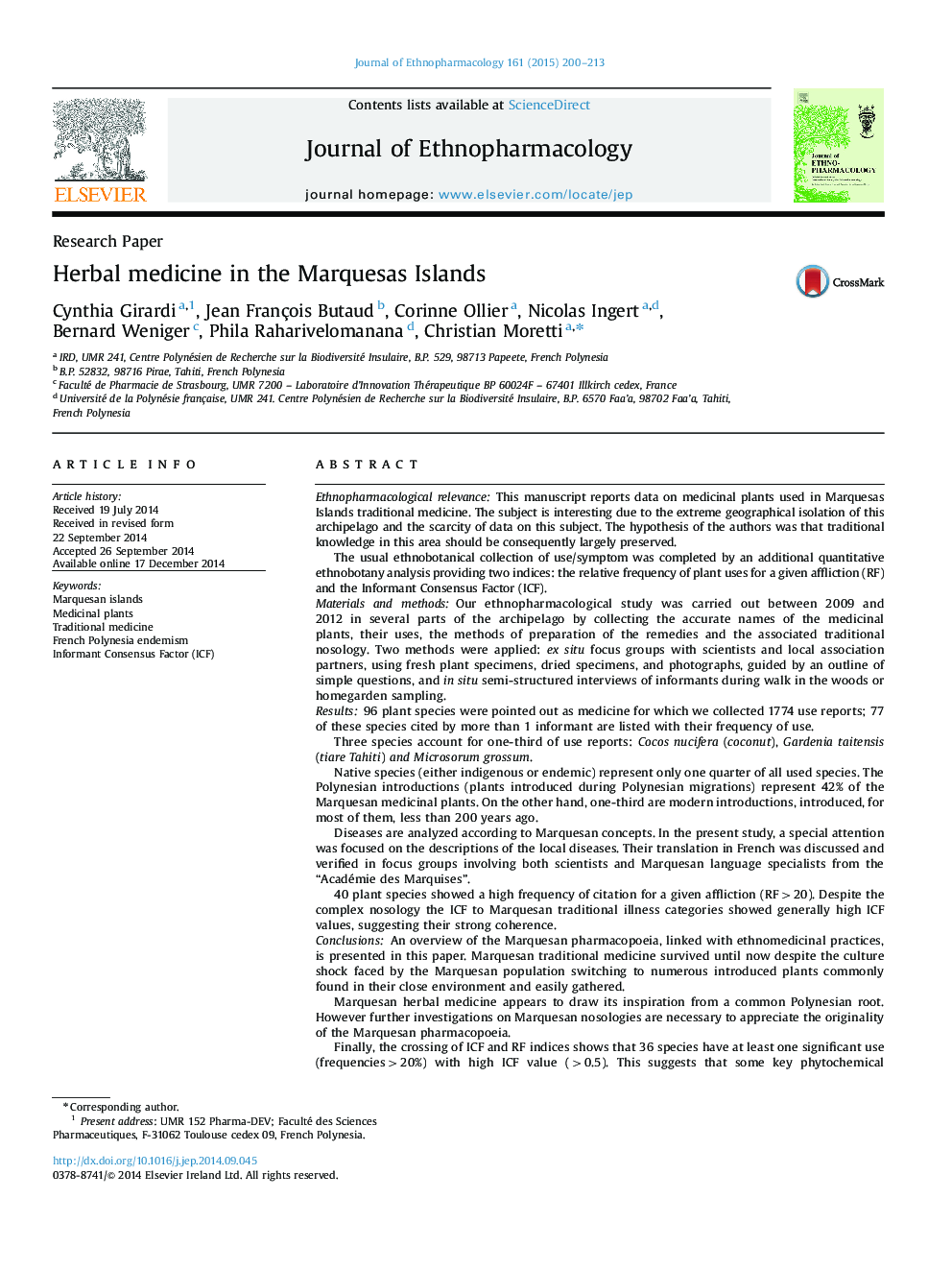| کد مقاله | کد نشریه | سال انتشار | مقاله انگلیسی | نسخه تمام متن |
|---|---|---|---|---|
| 5835576 | 1560401 | 2015 | 14 صفحه PDF | دانلود رایگان |
Ethnopharmacological relevanceThis manuscript reports data on medicinal plants used in Marquesas Islands traditional medicine. The subject is interesting due to the extreme geographical isolation of this archipelago and the scarcity of data on this subject. The hypothesis of the authors was that traditional knowledge in this area should be consequently largely preserved.The usual ethnobotanical collection of use/symptom was completed by an additional quantitative ethnobotany analysis providing two indices: the relative frequency of plant uses for a given affliction (RF) and the Informant Consensus Factor (ICF).Materials and methodsOur ethnopharmacological study was carried out between 2009 and 2012 in several parts of the archipelago by collecting the accurate names of the medicinal plants, their uses, the methods of preparation of the remedies and the associated traditional nosology. Two methods were applied: ex situ focus groups with scientists and local association partners, using fresh plant specimens, dried specimens, and photographs, guided by an outline of simple questions, and in situ semi-structured interviews of informants during walk in the woods or homegarden sampling.Results96 plant species were pointed out as medicine for which we collected 1774 use reports; 77 of these species cited by more than 1 informant are listed with their frequency of use.Three species account for one-third of use reports: Cocos nucifera (coconut), Gardenia taitensis (tiare Tahiti) and Microsorum grossum.Native species (either indigenous or endemic) represent only one quarter of all used species. The Polynesian introductions (plants introduced during Polynesian migrations) represent 42% of the Marquesan medicinal plants. On the other hand, one-third are modern introductions, introduced, for most of them, less than 200 years ago.Diseases are analyzed according to Marquesan concepts. In the present study, a special attention was focused on the descriptions of the local diseases. Their translation in French was discussed and verified in focus groups involving both scientists and Marquesan language specialists from the “Académie des Marquises”.40 plant species showed a high frequency of citation for a given affliction (RF>20). Despite the complex nosology the ICF to Marquesan traditional illness categories showed generally high ICF values, suggesting their strong coherence.ConclusionsAn overview of the Marquesan pharmacopoeia, linked with ethnomedicinal practices, is presented in this paper. Marquesan traditional medicine survived until now despite the culture shock faced by the Marquesan population switching to numerous introduced plants commonly found in their close environment and easily gathered.Marquesan herbal medicine appears to draw its inspiration from a common Polynesian root. However further investigations on Marquesan nosologies are necessary to appreciate the originality of the Marquesan pharmacopoeia.Finally, the crossing of ICF and RF indices shows that 36 species have at least one significant use (frequencies>20%) with high ICF value (>0.5). This suggests that some key phytochemical ingredients may be present in these plants which require further phytopharmacological studies to a better knowledge of their medicinal properties.
243
Journal: Journal of Ethnopharmacology - Volume 161, 23 February 2015, Pages 200-213
